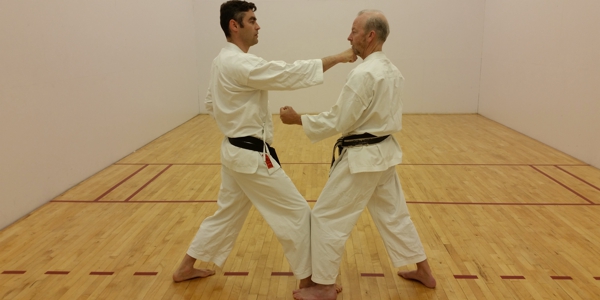To me, the process of learning karate techniques has always meant uncovering the technique’s true nature and looking for the “magic” hidden deep inside. I was trying to find something that reflects a techniques fundamental nature, the formula for perfect movement. Years of study with top instructors, and much self-searching, brought me to the point of realization that the internal and external aspects of movement are inseparable, dependent on each other. And although, in an evolved technique, KI energy takes the leadership the ability for efficient use of muscles remains crucial.
Vertical slingshot is a movement pattern which combines internal and external aspects of technique and does so in optimal proportion – the way which “extracts” maximum energy out of the movement. That translates into unique quality and another level of performance, especially when speed, power and elusiveness are searched for.
In terms of force creation, vertical slingshot is the only way to fully utilize the potential our body offers. The process is based on complete activation of the body through efficient use of breath and optimal configuration of its physical structure (I cover this part in my videos explaining the meaning of karate stances). As a result the technique becomes a unified current of energy with all different segments supporting the effort to fullest extent.
Vertical slingshot is an essence of karate technique. It exposes internal uniformity of all externally different movements and techniques and serves as an internal compass providing unique energetic guidance towards improvement. It is the most efficient way of using the body to achieve maximum power. Is all-embracing character applies equally to all different types of techniques –blocks, punches, kicks, stepping and sliding, etc. What’s more – its true universality makes it applicable for sports different than martial arts as well. Vertical slingshot may be successfully transferred to various disciplines and individual routines. It can greatly improve footwork/versatility of a tennis player, reaction time of a goalie or enhance the kicking speed and power of a MMA fighter.
Although there is no limit to creative use of the vertical slingshot in different sports in this article I am going to focus on its general characteristics only. I am also going to use one specific example – karate front kick – to illustrate how the process works on body levels. Lastly, I will narrow down theoretical part to it’s physical aspect.
Vertical slingshot requires total concurrent body activation (not to be confused with movement of an entire body) which due to its short duration provides the movement with an explosive quality.
On a physical level total activation is determined by two things:
Optimal body alignment (required for achieving maximum level of interaction between centered body structure and the ground; can be regarded as ‘pipeline’ for rapid energy flow through the body)
Correct use of breath (vital tool used to instantly energize entire physical structure of the body; the real substance behind energy creation).
The entire process of combining these two in practical application can be compared to a human-shaped balloon (like those the car dealers often use) instantly filling up with air – with all its parts (legs, torso, arms) stretching out simultaneously as a result.
Optimal body alignment allows different body segments to work in unison by forming energy lines or “power lines”. These energy lines become the channels for compressed energy flow downward and simultaneous reaction flowing upward (in form of technique).*
Understanding karate stances and their intended (energetic) meaning is crucial for optimizing physical alignment of the body (it is also a part of the online karate manual “Deciphering Perfect Design” available on www.internalkarate.com in form of video material).
The energy lines formed by different body segments must constitute the energetic web so that it can support the movement and allow sufficient energy buildup. That means that they have to provide the strongest support for the intended action by fully utilizing the anatomical aspect of the human body.
In their character the energy lines differ slightly and generally can be divided into two categories:
lines X providing direct support towards movement/technique (direct line of power delivery)
lines Y providing indirect support towards technique by enforcing lines X**
The movement/technique has to always rely on activating these lines in the correct manner (also to energetically unify the movement) with the purpose of creating and delivering the maximum amount of energy through the intended action. That involves situations where the body changes its position, covers the distance or performs action in a stationary manner.
*It can be said that vertical slingshot is the process of concurrent creation and handling of the energy being created this way. Interestingly, techniques formed this way share their explosive quality with that of natural flow or pulsation. Their smoothness and genuine explosiveness is the result of the energy taking the leadership and guiding the body rather than being entrapped within bounds of excessive mechanicality.
**Detailed explanation of energy lines and their role in different techniques will be the subject of my next article.
The second element that is vital for achieving quality of the vertical slingshot is correct use of breathing.
Breathing is a necessary tool to activate the body structure from inside. It cannot be separated from body posture – even a slight imperfection in body alignment will make the breathing action useless. It always helps me when teaching to bring an analogy between breathing being used for physical movement initiation (start) to water starting to flow under high pressure (breathing/energy) through a perfectly solid pipeline (posture/alignment).
Although it is impossible to fully explain entire subject regarding breathing here, I am going to focus on the essential aspects of its practical application.
First of all, breathing has to be fully synchronized with physical action – it initiates its start and completes at its finish. Breathing assists in creating maximum energy throughout the technique’s course by increasing its rate along with the raising the rate of muscular involvement up to the point that they both peak. Once a technique is complete and all this freshly created energy has reached its destination the cycle is complete. When performed correctly it results in automatic recharge of the body system – the inflow of fresh air/energy is automatic and happens as a result of explosive air/energy outflow. It is to be said here, there is no need to inhale during fast sequences of movements (for example combination of techniques). As a matter of fact, inhaling in martial arts exposes the fighter both physically and strategically.
Optimal use of breath within continuous movement sequences could be compared to riding the ocean waves: each move – different wave. Although the waves will vary due to their length (strength), the process of riding them has an energetically unifying quality.
Example – front kick/mae geri
Let’s consider the case of the front kick and use it as an example for this study.
Let the regular fighting stance be the starting position for the kick (Pic 1).
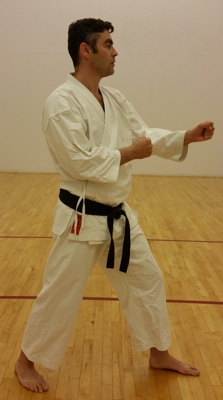 Pic 1. Starting position
Pic 1. Starting position
The kick begins with an exhale and simultaneous pressure being applied along the support leg (in this case left) towards the floor (the initiator is breath activating the body along support leg in downward direction). Continuous exhale increases the pressure towards the ground and converts it into kicking foot acceleration which increases technique’s momentum. The applied pressure is the technique’s start, middle and the finish, progressing in its range from minimum to maximum within short duration of time*. Pressure towards the ground can be viewed as energetic extension or “rooting” that reaches its maximum at the time of kime (top of mental and physical focus). Optimal involvement of the support leg is crucial for maximum increase in the technique’s momentum and as previously stated requires maintaining correct posture with all body segments stabilized and forming a unified energy line. The action of rooting and increase in kick’s momentum have simultaneous character – in vertical slingshot they are practically inseparable. In order to check that interaction simply use help from your training partner as shown at pic 2 and 3.
* Short duration of time means the time needed for momentary activation of entire body and equals the time needed for full, sharp exhalation; it amounts to time needed for energy to travel throughout the body in form of pulsation/explosive reaction (the time energy needs to complete its cycle).
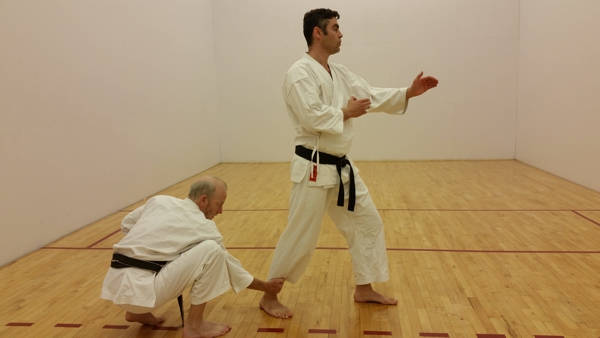
Pic 2. Resistance being applied against the ankle of kicking leg; the purpose here is to provide feedback rather than paralyze the movement at its early stage (although performed correctly it should never feel weak); while trying – maintain stability of bottom part of the spine and avoid leaning forward or falling backward. The best results will be achieved only while the posture remains fully balanced.
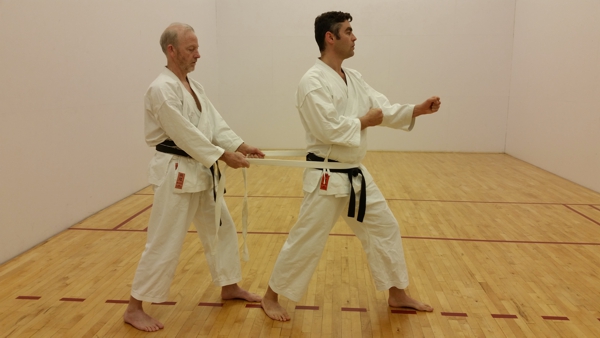
Pic 3. Initial stage of front kick can also be tested by training partner resisting with the belt; keeping the tailbone fully stable and utilizing the breathing from the very start is necessary for rooting the kick and allow maximum energy increase from the very start.
A common way of starting the front kick is by raising the knee up too early lacks internal activation and uses fraction of the potential offered by the kick (Pic 4). Such technique lacks both energetic unity and full body activation due to preventing the breathing and the muscles from acting in a synchronized way from the very start.
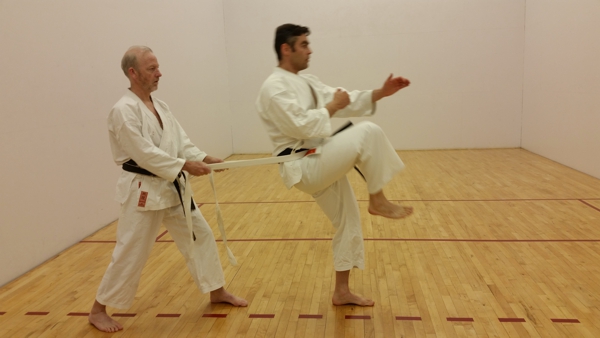
Pic 4. Knee of the kicking leg raised at the very start of the kick; in such case applying even slight resistance will efficiently stop the effort due to lack of internal activation and authentic energy increase during initial stage of the kick.
The above examples refer to the initiation/increase stage of the front kick – movement ranging from start to the point where feet pass each other. The moment of feet passing each other is the moment of ‘energy climax’ when the continuous energy build up reaches its maximum (Pic 5).
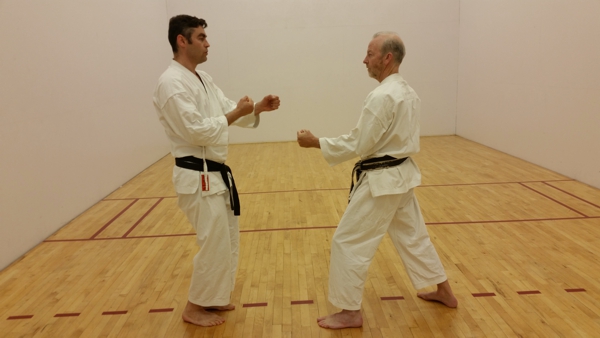
Pic 5. Moment of feet passing each other is the moment when initial energy increase reaches its maximum and redirects the energy in form of vertically oriented reaction (body frame acts as a ‘pipeline’). The moment when energy level reaches its climax and “becomes” the technique.
Although the energy “climax” lasts for very short time it does grant a freedom of controlled energy application in different ways. In a way it acts as an “internal switch point” – serving as an electrical multi plug outlet – allowing energy to become either the kick (front, side, roundhouse) or oi-zuki punch (Pic 6a,b).
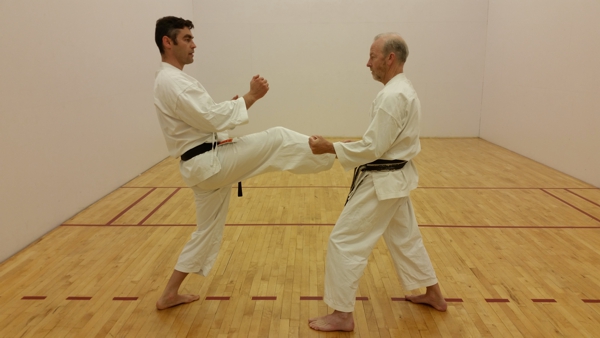
Pic 6a,b. Internal switch point allows in the altering of the energy (choice of technique)
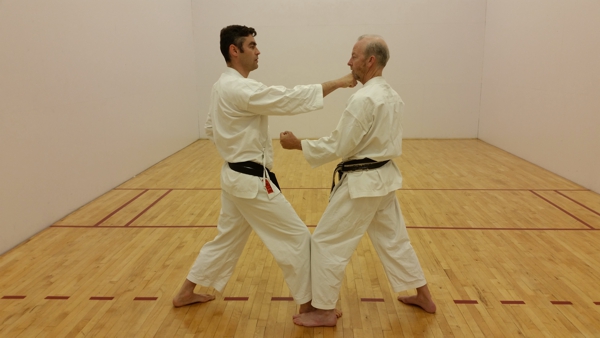
Although the final decision (which technique is performed) is determined by mental intention, vertical slingshot is the only movement pattern allowing that level of control and adaptability. It allows full mind control over the breath and full breath control over the body during execution of the technique (which could be defined as controlled/intentional energy release).
The stages of initiation/increase/climax/release described above account for one full energetic cycle of movement. They are inseparable and apply in identical manner to all externally different karate techniques regardless which parts of the body they involve. On a physical level this full energy cycle is self – containing. Explosive action of entire body system results in total automatic energy restoration – the air is back right when kime reaches its peak. Bear in mind that no inhale is needed while performing these techniques or combinations of techniques in such manner.
The technique’s energetic shape pass the point of reaching energy climax and other determining factors crucial for movement’s effectiveness will be the subject of another article.

